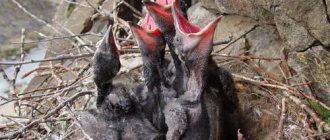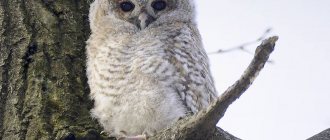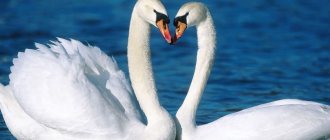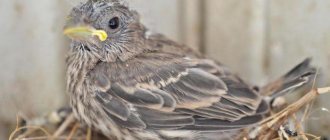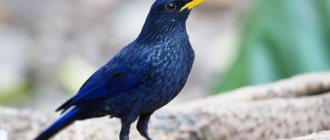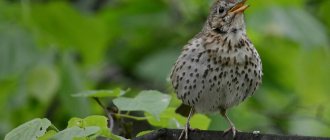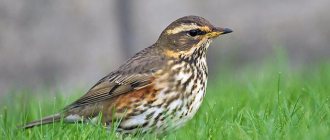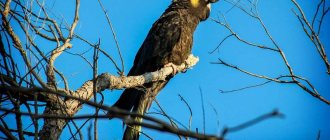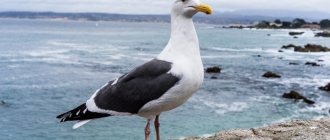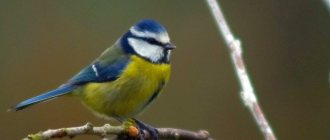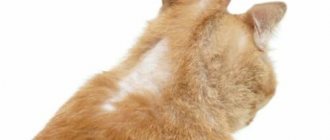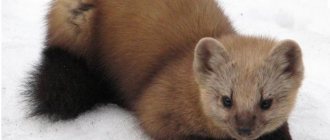Not only in terms of species diversity, but also in terms of numbers, blackbirds occupy one of the first places. Every fifth bird you see in the forest is a representative of this family. Despite this, thrushes are much inferior in popularity to swallows and starlings. Most people have no idea what an adult bird looks like or what to feed a chick found on the street.
In this article you will learn what a thrush chick looks like, how to feed it at home and prevent the development of various infectious diseases that reduce its immunity. With some effort, you can grow it into a beautiful songbird within a month.
The blackbird chick fell out of the nest - what to do?
In the warm season, you can often find small fledgling thrushes in the grass, sitting on the ground, waiting for their parents to bring them the long-awaited food. Remember that by taking such a baby home, you are taking on a serious responsibility, which not everyone can handle, because the parents will take much better care of the brood. However, if the chick’s life is in immediate danger, and you have firmly decided to take care of it, then you need to know a few basic rules. Guided by them, you will be able to raise a beautiful bird from a newly fledged lump, which will delight you with its unique singing if you leave it in the house.
Nesting
Thrush nests are made of twigs, moss, leaves, roots, reinforced with clay or earth. You can find nests in trees, on the ground, and in bushes. It all depends on where the blackbird thinks is safest.
Blackbirds prefer to avoid dark places for nests, and therefore build them in the shape of a bowl in the bushes at the edge of the forest or near a forest clearing. During the year, the female lays up to five times, producing 4-5 eggs. After two weeks, chicks emerge from the eggs. Both parents take part in raising and feeding the chicks.
Interesting! Blackbirds are very brave creatures. They rush at enemies if they encroach on their nests and offspring. However, if the enemy is large or stubborn, the female or male pretends to be hit and limps away, luring the enemy away from the house.
With the onset of cold weather, blackbirds gather in large flocks and go south for the winter.
During the year, the female lays up to five times, producing 4-5 eggs. After two weeks, chicks emerge from the eggs. Both parents take part in raising and feeding the chicks
Chick development
The female blackbird lays from 3 to 6 eggs per clutch. Having hatched, the chicks develop very quickly and within a few weeks make their first flight from the nest to the ground. As soon as the thrush chick, the photo of which is located below, grows up and masters the ability to fly, its mobility increases several times.
It is noteworthy that the chicks strive to leave the nest as quickly as possible in order not to become prey for cats, crows and other birds of prey. Hiding in the grass, they often sit motionless until their parents bring food. Adults know exactly where they are, so you should pick up a little blackbird that has “fallen” from the nest only if there is a real threat to its life.
After about a month, the thrush chick begins to make its first sounds, which will later develop into full-fledged singing.
Reproduction and offspring
With the onset of spring, birds begin to prepare their nests for the breeding process. They strengthen and insulate them, using dry branches, straw, feathers, leaves, as well as moss and lichen for these purposes. Clay is also used to strengthen the frame. On the outside, it serves as the component that improves the mechanical properties of the socket. From the inside, down or feathers are used for insulation.
The thrush's nest can be located at a height of about 6 meters. The female lays up to 6 eggs, and during the season, under favorable conditions, she can do this twice. The eggs can be quite variegated in color. When re-laying eggs, it should be the end of June, the beginning of July.
The female incubates the eggs for 2 weeks. After the chicks are born, both parents feed them. They do this one by one, flying out of the nest up to 200 times per day. Within a couple of weeks, at most, the chicks are able to leave the parental nest. Unfortunately, not all of them will be able to survive, since not all of them can get food for themselves.
Appearance
The appearance of small blackbirds is quite characteristic - they look stubby. This is directly related to the fact that their tail feathers have not yet grown. The beak, a rich yellow color, is surrounded by special ridges that visually enlarge the beak, indicating to parents where to place the food they bring.
Since the feathers are not yet fully formed in some places, they do not cover the body, which is why the thrush chick has a rather unkempt appearance. Despite this, his eyes are already fully open, and he can fully move on his paws.
When very frightened, the chicks allow themselves to be controlled, but if the parents are nearby at this time, they will try, if possible, to protect the baby from encroachment.
Lifestyle and character of the fieldfare
Chickens lay small eggs: reasons and what to do?
The fieldfare thrush leads both a sedentary and nomadic lifestyle. This depends on the climatic conditions of residence and the availability of food in winter. Those who left their homeland and flew south return early, already in mid-April.
During wintering and upon returning home, flocks of fieldfares number about 80-100 birds. Having arrived, the birds remain for some time in the suburbs, on the edges, in the floodplains of rivers, where the snow has already melted and food has appeared. When the snow completely melts, the flock looks for a nesting site. The colony takes several days to form.
Its core consists of old birds - founders, experienced nest builders. This “backbone” occupies the best places for nests, and in general determines the nesting site of the entire colony, based on their everyday experience; adult birds determine the feeding capacity of the place, convenience in case of protection.
Colonies usually consist of 12-25 pairs of birds. The fieldfare thrush differs from many birds in that, despite its small size, it is very courageous, self-confident and always in a fighting mood regarding perceived enemies.
Large birds - crows, magpies, which easily destroy the nests of warblers, finches and other small birds, will not interfere with the fieldfare colony. Even a lone male will fiercely defend his home. And when the birds gather together, they attack the predator using their favorite and very effective method - they cover the enemy with droppings.
Moreover, this is quite dangerous for attacking birds, since stuck together feathers make it impossible to fly. Any terrestrial predator, and even humans, will be met in the same way. But, despite such belligerence towards large birds and animals, fieldfare never offends small birds living in the neighborhood.
Many pichugas deliberately settle nearby, knowing that in the fieldfare bird colony they are not afraid of attacks from crows, squirrels or cats. But still, fieldfare also suffers from predators. Hawks catch them, jays, woodpeckers, and owls try to destroy their nests. Prolonged summer rains and cold are also dangerous for nests.
But an independent colony of fieldfares searches for the best places for their nests every year. This bird does not have great vocal abilities - the song of the fieldfare thrush is an ordinary chak-chak. But there are also alarms that sound like crackling sounds. A thin and long whistle means “hawk”.
Listen to the voice of the fieldfare
Most common types
In the CIS, five species of blackbirds can most often be found:
- Belobrovik.
- Fieldfare - its singing is a mixture of creaking and chirping.
- Deryaba is one of the largest blackbirds. Prefers to sing away from human eyes.
- Blackbird - sings, located at the top of the trees.
- The song thrush is the most numerous and most vocal species.
Knowing what a blackbird chick looks like can help you determine what species it belongs to and, with the help of a veterinarian, choose the most suitable diet for it.
Most often, the singing of blackbirds can be heard at dawn, starting at 4 am, and in the evening - in the evening before sunset. If you decide to catch a young individual yourself, keep in mind that if you fail, you will have to wait at least a year, because these birds are very distrustful and remember well the places where they were in immediate danger.
Description and features of the thrush bird
There is one amazing bird in the passerine order, the existence of which we have known since early childhood - the thrush bird. In total, there are about 62 species in this passerine family, of which 20 species live in Russia. The most popular is the song thrush, with a body length of about 25 cm and a weight of up to 100 g.
This beloved singer and berry lover was previously considered a forest bird. But he has become so accustomed to the presence of a person next to him that now one can hear the thrush singing not only in the forests, but also in city squares.
Fieldfare Thrush
His singing sounds especially beautiful in the early morning and calm evening. There are times when the thrush sings even at night. It is worth noting that many music connoisseurs noted about 20 sounds in his singing, and this is even more than that of the nightingale we all adore.
Chicks that have just been born make the thrush sing much more melodiously. The blackbirds' repertoire includes about 85 trills, which you can listen to endlessly and with pleasure.
Mistle Thrush
Many people use recordings of these melodies for relaxation and meditation. Blackbirds are difficult to classify as solitary or flocking birds. They feel comfortable in all cases.
The song thrush can be distinguished not only by its amazing singing, but also by its color. Brown and silver colors predominate on the back and tail of the bird. Yellow shades and brown spots are visible on the chest.
song thrush
The area under the wings of the bird is colored red. There are no significant differences between males and females of this bird species. Young birds are distinguished by their not pronounced color.
There is a thrush with the strange name white-browed. But once you take a closer look at it, it becomes clear why it was called that. The bird's eye area is decorated with white eyebrows, which makes the bird not only beautiful, but also easily recognizable.
Pictured is a blackbird
Its back is olive with a brown color, the places under the wings and sides of the bird have reddish tints. The blackbird is completely black. One beak is bright orange against a background of black paint. This bird is probably the most cautious of all its relatives.
The color of the Field Thrush is brown on the back. Its belly and underwings are white, and the tail and wings of the feathered bird are dark brown, sometimes black. Variegated colors are visible on the sides and chest.
Pied blackbirds have a blue-gray head. The feathers and tail of the bird are orange. And along the back of the bird a white stripe is clearly visible. In the winter season, the variegated orange tones disappear from the bird’s color, and the bird completely becomes gray.
The color of the belly is white with spots. The bottom of his wings are the same. This thrush has a slightly longer tail than all its other relatives. Females are absolutely impossible to distinguish from males.
The color of male bluebirds is dominated by gray-blue tones. Their tail and wings are black. The color of the female is brown. Birds have fairly long limbs and thanks to them they move straight. The flight of birds is also straight and swift.
It is interesting to watch how blackbirds move on the ground. They first squat and then jump. In between jumps, the bird's head tilts to the side. In this position, the bird tries to catch extraneous sounds of possible enemies or examine prey for itself, because the eyes of birds are located on the sides.
White-throated Thrush
In a photo of a thrush it is impossible to see all the beauty of the bird. Everything is much more natural and beautiful in real light. And if the delicate beauty of a bird is accompanied by its unusual and incomparable singing, you fall in love with it at first sight. The thrush bird can be described in a few words - a singing, not very attractive, but surprisingly cute bird.
Features of feeding
You should know what to do if a thrush chick appears in your house, what to feed it and how to treat it for parasites. Keep in mind that you take on enormous responsibility and must provide him with a nutritious diet. A lack of vitamins can significantly affect the health of your pet; its already weakened immune system, exposed to daily stress, may not be able to cope with most viral infections, and the thrush will begin to get sick.
Adequate feeding will not only improve health and appearance, but also prepare the bird for further reproduction. If you plan to release your grown-up baby into the wild in the future, you should try not to pick him up, since, having gotten used to you, he will completely cease to be afraid of people, considering you his parent, and may simply not survive in unusual conditions. him the conditions of the natural environment.
Thrush chick - how to care?
Keep in mind that the amount of food required by the bird should vary depending on its condition and time of year. For example, a newly picked thrush chick eats twice as much food as one that has already settled down.
In females during the period of oviposition, the appetite increases several times. At this time, they should be provided with a sufficient amount of animal food required during the period of intense singing and increased sexual activity.
Complete diet
The first thing you need to do after a blackbird chick has fallen out of the nest is to inspect the surrounding area. In the event that his life is not in significant danger, it is better not to even touch him. However, if it does get into your home, first of all inspect it for the presence of parasites. Moreover, these can be not only fleas, but also ticks, which often attack chicks while they are still in the nest. If detected, thrush feathers must be treated with a special substance, which can be purchased at a veterinary pharmacy. It is not recommended to carry out preventive treatment, because you should not expose the chick to stress again.
If the thrush chick has not yet acquired its own feathers, it should be heated by maintaining a room temperature of 26 to 28 degrees. A heating pad wrapped in a clean towel is ideal for these purposes.
What do blackbirds eat in the wild?
Blackbirds are among the omnivorous birds that feed equally well on both plant and animal foods. The diet of blackbirds directly depends on the season. So, in winter, like other birds, it is quite scarce. In winter, the diet consists of fruits, berries or seeds, which birds can find on trees or fruit bushes. During this period, the favorite delicacy of birds is considered to be rowan or rose hips. In summer, the diet is more extensive, which creates a need for birds to stay closer to areas where berries and fruits ripen.
At times when there is a lean time, thrushes are able to carry out raids on vegetable gardens and orchards, which is why the entire crop often suffers.
Blackbirds cannot do without food that contains large amounts of protein.
This necessitates the need to look for food in the form of beetles, earthworms, snails and insects. The summer diet includes caterpillars, while in the fall blackbirds have to be content with fruits and seeds. At the same time, thrush chicks are very voracious; their parents have to constantly obtain food to feed their offspring.
Elena
Ask a Question
Question to the expert
Why do blackbirds eat chick droppings?
Adults do this in order to prevent the appearance of parasites in the nest, as well as to prevent excess odor that would attract predators. The droppings capsules produced by the chicks are a mucous membrane containing excrement and uric acid. The shell is designed in such a way as to prevent the contents from spreading throughout the nest, which helps birds protect themselves from various bacteria and easily throw the capsule out of the nest. Blackbirds usually throw out such capsules using their beaks. However, some bird species may eat them as it is considered quite nutritious.
Animal feed
Animal feed provides birds not only with animal proteins, but also with many minerals. To prepare a complete diet, a mixture of grated boiled eggs and cottage cheese, which contains B vitamins necessary for full development, is suitable.
Of the meat products, it is best to use offal. Minced meat or boiled fish is best. It is periodically added to the daily food that your thrush chick eats (photo with an example of feeding is located below).
However, keep in mind that if you want to provide the chick with natural nutrition, it is best to feed it with ant pupae, which can be found by digging up almost any anthill, mealworms, wax moth caterpillars, bloodworms and even small mice. When feeding, it is worth considering that adult thrushes can easily cope even with voles.
Habitat
As already mentioned, most recently the favorite habitat of blackbirds was forests. Nowadays, they can be found in city parks and squares. It is important for birds to have food in their habitat, and they are already accustomed to society.
Blackbirds can migrate long distances in search of food. Most species of thrushes live in Europe, America, and Asia. During winter cold they prefer to be in southern places with a mild climate.
Birds don’t like intense heat, so in Africa birds are found only in its northern regions. The blackbird is a migratory bird that prefers a warm or temperate climate, and therefore makes its migrations to southern latitudes.
Almost the entire territory of Russia is inhabited by blackbirds. They can be seen not only in forests and parks, but also in steppe areas. These birds are not afraid of extreme cold. The main thing is that there is enough light in their habitats. Birch groves are most suitable for thrushes. They are less common in coniferous forests.
Mineral feed
In nature, birds obtain all the necessary vitamin and mineral components as a result of consuming various additives. Thus, blackbirds need river sand, due to which their bodies grind roughage, consisting of various grains, greens and branches.
Providing birds with such feeding allows them not to disrupt their proper metabolism, even when kept at home. For example, carrots, which contain a large amount of carotene, must be present in the chick’s daily diet, making up about 30% of the food you prepare.
Vitamins
In addition, you should constantly add crushed eggshells to their daily diet, after boiling them, crushed chalk, shell rock and charcoal, which provide additional strength to the bones. Special attention should be paid to a variety of berries, which should be prepared for poultry for the winter, drying them in bright, well-ventilated areas.
As a stable source of microelements, multivitamin tablets or honey can be added several times a week to the water that the chick drinks, which indirectly helps strengthen the immune system. However, keep in mind that if you purchase ready-made vitamin preparations at a veterinary pharmacy, you should strictly adhere to the instructions, because an excess of vitamins can cause the same harm to the thrush as their deficiency.
Hollows and artificial dwellings
Great Spotted Woodpecker
The Great Spotted Woodpecker lives in tall mixed and pine forests, small groves, gardens and parks. It nests in hollows of dry or living trees, preferring species with soft wood. The hollow is most often located at a height of 2 to 5 m from the ground. The inside of the nest is lined with small pieces of wood. The woodpecker lays eggs in late April - early May.
It is not for nothing that the woodpecker is called the forest orderly; this useful bird in spring and summer rids trees of numerous pests - bark beetles, chafers, bedbugs, ants, and in winter it switches to seeds of coniferous trees, hazel, and acorns.
The common starling lives in open forests, gardens and parks. It nests near human dwellings and occupies artificial nesting sites - birdhouses, niches under roofs and balconies, as well as hollows left by different species of woodpeckers. Birds prefer to settle in colonies, with several pairs nearby. The nest is lined with soft grass, straw, and bird feathers. Starlings arrive in the middle zone very early; eggs appear in the nests in April; in the southern regions there are two broods per season.
Common Starling
The benefits of birds are undoubted; starlings destroy caterpillars of insect pests, slugs, chafers and their larvae in gardens and orchards, in potato fields; they eat flies, gadflies, horseflies and their larvae in pastures; in the southern regions they catch various locusts. At the same time, starlings can damage the harvest of gardens and vineyards, but while eating berries, they also collect harmful insects.
The great tit settles near humans more often than other birds, lives in parks, gardens, sparse deciduous forests, and avoids dense coniferous forests. The nest is made in closed places - hollows, nests of squirrels or birds of prey, in birdhouses or artificial nests (dugout houses), in crevices of buildings. The building materials are moss, thin plant fibers and twigs, wool, fluff, and cobwebs. Nesting in the middle zone begins in the second half of May.
Great tit
The tit feeds on insects and spiders, their eggs, and caterpillars, which it finds on tree trunks. In autumn and winter, birds switch to plant foods, eat seeds of various herbs and trees (burdock, quinoa, sunflower, spruce, pine), remove seeds from berries, and can eat food waste near their homes. In harsh winter, when there is a lack of food, they happily fly to feeders in gardens and parks.
